The Interesting Case of Dr Sam Sheppard that Sparked an Award Winning Movie
The story at the heart of The Fugitive.

Many people remember the line from the 1993 film The Fugitive, Our fugitive's name is Dr Richard Kimble. Go get him. Very few people may realise that the story bears a remarkable resemblance to Dr Sam Sheppard's real case.
In the film, Harrison Ford's character is wrongly accused of killing his wife. The killer is a one-armed man, an outstanding feature. In the case of Sheppard, the man was bushy-haired, another distinguishing feature.
Dr Sam Sheppard
Sheppard was born on 29th December 1923 in Cleveland, Ohio. His father was a doctor, and he came from a good family. He was described as intelligent and athletic. Having been offered several scholarships for his sporting prowess, he followed his father into medicine. Sheppard enrolled in university to become an Osteopathic Physician; different from an Osteopath, a physician in this field can operate and prescribe medication.
In 1945, he obtained his degree and married his childhood sweetheart Marilyn. He stayed in Los Angeles to practise medicine until 1951, when he returned to work in his father's practice. The practice was in Bay Village, Ohio, and Sheppard returned with his wife and his young son Samuel junior and their dog Koko. Koko would play an essential part in the case as it was his lack of barking when an intruder entered the house that led authorities to believe the killer was Sheppard himself.
The marriage was not without its problems. Sheppard was having an affair with a nurse named Susan Hayes; it is widely thought that Marilyn knew about the affair, and the couple were working on their marriage. In addition, Marilyn was pregnant with their second child when she was killed.
The tragic night.
On 3rd July 1954, the Sheppard's were entertaining friends, the Aherns. After dinner, they went to watch a movie, where Sam fell asleep in the chair. Marilyn said goodnight to her guests at midnight and left Sam sleeping in the chair downstairs.
In the early hours of the morning, Sam was awoken to the screams of his wife. He went upstairs, where he stated he saw a man standing over Marilyn with bushy hair. The pair fought, Sam was knocked briefly unconscious. Coming round, he checked on his son and pursued the attacker. He caught up with the man on the beach where they fought again, and Sam was again knocked unconscious. When he gained consciousness, he was without a shirt, and the perpetrator was nowhere to be seen. Marilyn had been bludgeoned to death in her bed.
At 0540, he returned to the house and phoned his friend and local mayor, Spencer Houk. He arrived at the house shortly, followed by the police at 6 am. The police describe a trail of blood leading to the body and signs that a robbery had occurred. Sam Sheppard was found with cuts and bruises and injuries to his neck. He was sent to the hospital to be treated.
The investigation
Whilst Sheppard was at the hospital, coroner Sam Gerber arrived. He began to suspect Sheppard immediately of the crime. He stated there were very few signs of a break-in, and no one had heard anything, least of all the dog and Sheppard's son, who had been asleep throughout.
What began was a media circus, where the public tried and convicted the Doctor before the police. When the police interviewed Sheppard, he gave vague details about the incident, only remembering that the assailant was a bushy-haired man. Within two weeks, the media had convicted him in the court of public opinion.
At the inquest, Sheppard's affair was discovered; this not only proved that he had lied to the police, having denied it earlier on, but gave him a motive for the murder. Accordingly, on 30th July 1954, he was arrested and charged with the murder of Marilyn Sheppard.
The trial
In August 54, the preliminary hearing was held and was considered one of the most published trials in history. Although, not until OJ Simpson would a case create as much interest, interestingly, this was not the last connection to the Simpson case that would occur. Sheppard was indicted on first-degree murder charges; it would be his last day of freedom for ten years.
The trial commenced in October, presided over by Edward Blythin. Blythin refused the request of the defence to hold the prosecution outside of Ohio, because of the attention. He would also fail to protect the rights of Sheppard during the trial by allowing jurors to stay who were biased. One incident involved two jurors who had listened to a broadcast regarding a woman arrested in New York claiming to have Sheppard's baby. The jurors were allowed to stay even with this biased opinion. The claims of the woman were later found to be untrue.
John Mahon was the prosecutor, and it was clear from the court records the state had little evidence against Sheppard. Instead, they gained their conviction on two factors; Sheppard's affair and his inconsistent story. On 17th December 1954, the jury retired for four days, coming back with a sentence of guilty of murder in the second degree. Sheppard was sentenced to life imprisonment.
The long road to justice
Tragedy continued to follow the Sheppard family. Sheppard's father had been diagnosed with stomach cancer, his mother unable to take this, and her son's conviction committed suicide, his father would die weeks later. By the end of January, both his parents were dead during the first month of his sentence.
William Corrigan, Sheppard's lawyer, would not stop trying to gain justice for his client. He hired criminologist Paul Kirk who conducted his investigation of the crime scene. Kirk uncovered that the assailant was left-handed; Sheppard was right. He also discovered a third DNA profile in the couple's bedroom.
Despite his many appeals for another trial, Corrigan was unsuccessful and died shortly after. This was when Sheppard's case was taken over by a young lawyer named F Lee Bailey. Bailey would later be one of the lawyers to represent OJ Simpson.
In 1964, Bailey filed a motion of Habeas Corpus, arguing that the media circus had resulted in Sheppard receiving an unfair trial. He had also uncovered evidence that the original judge had spoken to several people convicting Sheppard before the case had been heard. The motion was passed from court to court until it reached the US Supreme Court who upheld the views of the defence.
The case was heard between February and July of 1966. With a verdict of 8–1 in the Doctor's favour, the trial was stated as unconstitutional. Thus, although not acquitted of the murder, Sheppard was one step closer to freedom.
In November of the same year, the case went back to trial. Bailey was a much more proficient defence lawyer; he torn the prosecution testimony apart and introduced the new evidence uncovered by Kirk years earlier. He also refused to put Sheppard on the stand due to his inconsistent story. A tactic he would later employ in the OJ Simpson case.
Sheppard was determined to not go back to prison, despite the outcome of the case. Taking into court an unloaded gun, popular thought is that Sheppard would have attempted death by cop if found guilty again.
On 16th November, twelve years after the murder, Sheppard was found not guilty and released a free man.
Life after jail
Once out of jail, Sheppard married a German woman he communicated with via letter whilst in prison. Unfortunately, the marriage would be short-lived, and they divorced in 1968.
Sheppard went back into medicine, but his skills were poor and out of date. Then, during a routine operation, he killed a patient; he resigned immediately. Then, without a job, he turned to alcohol and some say pills.
In a strange twist, Sheppard had become a wrestler whilst in prison. When he met a wrestling promoter, the promoter persuaded him to enter the ring as a profession. He also went on to marry the promoters twenty-year-old daughter. Sheppard played the cartoon baddie in the ring, fighting under the name of Killer Sam Sheppard. Unfortunately, this career would also be short-lived. Sheppard died on 6th April 1970 at forty-six from a brain and heart problem brought on by alcohol and pills.
Who killed Marilyn Sheppard?
With the loss of his father, Sam Sheppard Junior was determined to find his mother's killer and completely clear his father's name. Unfortunately, it was not successful, but he did uncover three suspects that may have been responsible for the murder during this time.
Richard Eberling was a handyman in the area who had washed windows for the Sheppard's. He was known to steal from the site and had been found with some of Marilyn's jewellery. He stated he obtained them after her death and passed a polygraph to this effect. Later in life, Eberling would be convicted of the murder of another woman; people would come forward throughout this time and state he had admitted he killed Marilyn Sheppard. The one factor against Eberling was that he was bald, so not bushy-haired. However, he had been known to wear a wig, so even this factor could not rule him out. The DNA evidence did not convict him but could neither clear him. Eberling died in prison in 1998 and never faced charges, if he was the perpetrator.
Another name that came forward as a possible suspect was that of James Call. He was also a thief, and theories remain that Marilyn caught him in the process of stealing her jewellery when he murdered her.
F Lee Bailey suggests that the perpetrator could have been someone far closer to the Sheppards. He states that Marilyn and Spencer Houk were having an affair. When Houk's wife found out, she attacked Marilyn with the fire poker from the property. The wounds on Marilyn are consistent with being committed by a female or petite man. He states the bushy-haired man Sam Sheppard fought with was Spencer Houk, and either through shock or loyalty to his friend, he never revealed this.
As most witnesses are now dead or very old, it is unlikely that anyone will ever solve the case. However, many people are still convinced the Sam Sheppard killed his wife. Was Sam Sheppard a man ruined by an unlawful conviction, or a killer who got away with murder?
Thank you for reading. If you enjoyed this article, please follow me, share it and give it a like. As a writer tips mean a great deal to me, so a massive thank you if, you send one.
About the Creator
Sam H Arnold
Writing stories to help, inspire and shock. For all my current writing projects click here - https://linktr.ee/samharnold






Comments
There are no comments for this story
Be the first to respond and start the conversation.